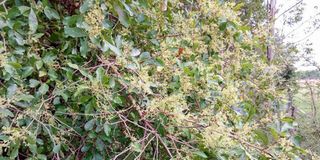Rhus natalensis: Tree scientists are banking on to save sandalwood

Branches and leaves of the Rhus natalensis or KwaZulu Natal rhus. The tree is one of the host plants of the highly valued but threatened Osyris lanceolata (sandalwood).
What you need to know:
- Its local names include Muthigiu (Kikuyu), Suriet (Kipsigis), Ol-mungushi (Maasai), Musigio (Samburu), Sangla (Luo), Musangura (Bukusu) and Muthii (Kamba).
- According to a study by Mary Gathara, Paul Makenzi, James Kimondo and Gabriel Muturi, it is one of the host plants of the highly valued but threatened Osyris lanceolata (sandalwood).
- Various parts of the tree are medicinal. Leaves and roots are used to treat heartburn, influenza, cough and abdominal pains. A decoction of the roots is taken as a remedy for diarrhoea among the Digo of the Coast.
- The tree is mostly propagated by seed although cuttings also grow well. Seed is best sown as soon as it is ripe. They should be soaked in hot water prior to sowing to leach out any germination inhibitors.
Rhus natalensis or KwaZulu Natal rhus is found across Africa, from Guinea to Arabia, Somalia to South Africa.
In Kenya, it grows in ecological zones whose altitude is up to 3,000 metres above sea level.
Its local names include Muthigiu (Kikuyu), Suriet (Kipsigis), Ol-mungushi (Maasai), Musigio (Samburu), Sangla (Luo), Musangura (Bukusu) and Muthii (Kamba).
According to a study by Mary Gathara, Paul Makenzi, James Kimondo and Gabriel Muturi, it is one of the host plants of the highly valued but threatened Osyris lanceolata (sandalwood).
Published in the Journal of Horticulture and Forestry in 2014, the study concluded that the two species grow next to each other in a symbiotic relationship.
This knowledge has helped scientists at Kenya Forestry Research Institute to step up domestication of sandalwood.
Sandalwood is threatened because of overexploitation in search of its high-value products that include oil, which fetches up to Sh250,000 a litre.
Many other benefits
The Rhus natalensis-sandalwood relationship in the wild led to further research in the race to save the latter.
The studies sought to answer questions such as at what point does one introduce host plants and whether the same hosts in the nursery work in the field.
“Some hosts are useful in the nursery but not in the field and vice versa,’’ says Frouza Maingi, a seed technologist at Kefri Kitui, who is involved in the sandalwood propagation.
Based on this information, Kefri has prepared demonstration farms with host trees already planted. The target is to propagate up to 10,000 sandalwood trees a year to provide Kenya’s seed capital.
Rhus natalensis has many other benefits. In their publication, Traditional Food Plants of Kenya, Patrick M.
Maundu, Grace W. Ngugi, and Christine H.S. Kabuye say its fruits are especially loved by children.
The bark is made into tea among the Maasai and Kipsigis. Roots are used in soup among the Kikuyu. Tender shoots are used as toothbrushes by the Bukusu and Maasai.
Various parts of the tree are medicinal. Leaves and roots are used to treat heartburn, influenza, cough and abdominal pains. A decoction of the roots is taken as a remedy for diarrhoea among the Digo of the Coast.
Traditional medicine
Its wood is good for fuel and charcoal while leaves are fodder for cattle. In their paper, “Antimicrobial activity of root bark extracts of Rhus natalensis and Rhus ruspolii,” Peter W. Njoroge and Sylvia A. Opiyo, concluded that extracts from the tree have anti-fungal and anti-microbial activities. It was published in the Basic Sciences of Medicine journal last year.
These findings support the use Rhus natalensis and Rhus ruspolii by Africans in treating bacterial and fungal infections.
Another research, “Phytochemical and antimicrobial studies on Rhus natalensis,’’ was carried out by Henry Mwangi of the University of Western Cape in 2011.
Extracts from the root bark, stem bark and leaves were screened for antibacterial activity against standard bacterial strains and fungi.
Some of the seven compounds isolated recorded high activity against bacteria and fungi.
The study showed that the use of this species in traditional medicine to treat infections and inflammatory conditions is justified. It recommended further studies to isolate more medicinal compounds in the tree’s extracts that could be formulated for use in the treatment of microbial or fungal infections.
Propagation
The tree is mostly propagated by seed although cuttings also grow well. Seed is best sown as soon as it is ripe. They should be soaked in hot water prior to sowing to leach out any germination inhibitors.
When they are large enough to handle, the seedlings are put into individual pots and grown until large enough to plant in the field.




